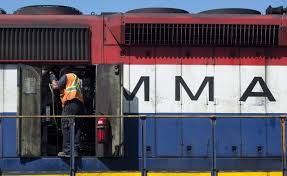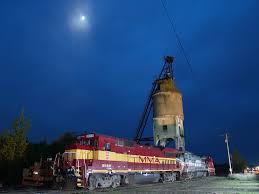Details About Company:
The Montreal, Maine and Atlantic Railway (reporting mark MMA) was a Class II freight railroad that operated in the U.S. states of Maine and Vermont and the Canadian province of Quebec between 2002 and 2014 as a branch of Rail World. It was headquartered in Hermon, Maine. Its Canadian subsidiary was named the Montreal, Maine and Atlantic Canada Company with offices in Farnham, Quebec.
Almost immediately after MMA began operations, two of the railway’s largest customers, a pair of Great Northern Paper mills in Millinocket and East Millinocket, declared bankruptcy and shut down. MMA responded by reducing its workforce to 275 employees and cut salaries by 40 percent.
The decline of the pulp and paper industry as well as the lumber industry, which originally represented 60% of the railways’ traffic base, had rendered a company worth $60 million in 2003 effectively worthless. Accountants from the la Caisse de dépôt et placement du Québec wrote that company’s investment in MMA down to a nominal $1000 from 2008 onward. MMA laid off additional workers in 2006 and in 2008 as the company struggled to become profitable. In the spring of 2010, MMA cut train crews from two workers to one, installing remote control and cutting the total workforce to 175 people (down from twice that number in 2006).

These steps were estimated to save $4.5 million annually in wages. Later that year, it sold the northern 233 miles (375 km) of the former BAR line to the state; this track was in very poor condition, but its sale brought $20 million, $7 million of which was used to repay a 2003 loan from la Caisse de dépôt et placement du Québec, an MMA stockholder.
MMA was the only Maine railway to use a single-person crew and a remote-control device instead of the more common two-person crews. Largely due to the lack of money for track maintenance and equipment, adverse winter weather conditions, and possibly the practice of running with single person crews.
from 2003 to 2013 MMA recorded an accident rate of 36.1 accidents per million miles travelled, versus a national average of 14.6/million miles traveled for all of North America, according to data from the Federal Railroad Administration. Freight volumes continued to drop as manufacturers, needing to meet customer demands for smaller quantity just in time delivery in order to reduce inventories, began to prefer trucking firms as faster and more reliable than MMA.
2008 proposal
A 2008 proposal to return passenger train service to the Eastern Townships on the 150 kilometers (93 mi) route between Montréal and Sherbrooke was studied but never implemented. The MMA-owned section of the line from St-Jean-sur-Richelieu to Sherbrooke would have required costly upgrades to tracks and bridges in order handle Via Rail passenger trains operating at 110 kilometers per hour (68 mph).
In 2011, the Twin Rivers Paper Company of Madawaska, Maine, the largest customer on the former BAR line, intervened in a United States District Court lawsuit which sought to allow the company to deal directly with Canadian National Railway (reporting mark CN) after years of problems with what it described as “MMA’s exorbitant pricing structure, ineffective service, and annoying executives.”
MMA was charging more to haul rail cars 24 miles (39 km) from Madawaska, ME to the interchange point with CN at St. Leonard, NB than CN demanded to carry this freight onward to Montreal, Quebec. MMA’s service and business practices had been subject to ongoing complaints from Fraser Papers Inc. and its successor Twin Rivers Paper Co. about missed pickup and delivery deadlines as well as poor track maintenance. Upon failing to break free from MMA’s local monopoly through legal action, Twin Rivers Paper Co. resorted to transshipment of its entire output across the Canada–United States border to Edmundston, New Brunswick by truck for placement directly on CN trains.

Notice of intent with the Surface Transportation Board
In early February 2010, the MMA filed a notice of intent with the Surface Transportation Board that it intended to abandon 233 miles (375 km) of track in northern Maine, between Madawaska and Millinocket, part of the original Bangor & Aroostook Railroad’s main line bought by MMA in 2003. Many portions of this track were in such poor condition that freight could only safely run at 10 miles per hour (16 km/h).
Affected lines were located in Penobscot County and Aroostook County, Maine, and included track serving Houlton, Presque Isle, Caribou and Fort Kent. MMA lines between Millinocket and Montreal, Brownville and Searsport, and Madawaska to Van Buren were not included in this application. According to MMA, losses from operating the lines had reached the point where they were threatening the financial health of the entire railroad.
The STB subsequently postponed action on the request in late April, after the railroad and Maine officials agreed to negotiate to prevent the lines from being abandoned, which the state said could negatively affect the economy of the area. State legislators proposed that the state buy the lines and contract out freight rail service, similar to lines in Vermont.
Agreement to sell 233 miles
On October 20, 2010, the railroad reached an agreement to sell 233 miles (375 km) of track in the northern part of Maine to the state government for $20.1 million; The Surface Transportation Board approved MM&A’s abandonment of the tracks on December 28, 2010, allowing the state to purchase them. Maine awarded a state contract to operate the line to J.D. Irving Limited subsidiary Irving Transportation Services on April 5, 2011 and completed $10.5 million worth of federally subsidized repairs to the long-neglected line in 2011-2012, including replacement of 50,000 ties and portions of the stone rail bed.
Irving Transportation Services, which owns and operates New Brunswick Railway Company (and subsidiaries New Brunswick Southern Railway / Eastern Maine Railway) established a new subsidiary Maine Northern Railway in June 2011 to operate the line, hiring an additional thirty workers and acquiring additional locomotives and rolling stock.
In December 2011, the MMA agreed to sell the remaining 25 miles (40 km) of track between Madawaska, Maine and Van Buren, Maine, MMA’s last track in northern Maine, to Irving outright. The red ink continued to flow; in 2011, MMA was losing four to five million dollars a year. An attempt to sell the entire MM&A operation in 2011 failed as US government loans provided to the railway were not transferable to a subsequent buyer.
Suspended freight service
MMA suspended freight service on July 16, 2012 over the Ste Rosalie Subdivision without prior notice to its customers. This 38 kilometers (24 mi) rail line connecting the MMA main line at Farnham, Quebec north to Sainte-Rosalie in the Montérégie region of Québec was inspected in May 2012 by Transport Canada and was deemed to be non-compliant with recently updated “Rules Respecting Track Safety” implemented by Transport Canada. The non-compliance was due to ongoing cost-cutting by MMA which resulted in deferred maintenance to the track between 2002 and 2012.
MMA claimed the new “Rules Respecting Track Safety” was a force majeure and sufficient reason to terminate train operations without first complying with Section 140 of the Canada Transportation Act detailing requirements for “Transferring and Discontinuing the Operation of Railway Lines”. The CTA legislation states that railway companies must give one-year advance notice. Two local clients affected by MMA’s suspension of service, F. Ménard Inc. and Meunerie Côté-Paquet, have since initiated lawsuits against the railway.
In 2013 MMA attempted to abandon the right of way and sell it to local municipalities. Because of the poor condition of the tracks on this section, if the sale were successful, the rails would likely be removed, and the property converted to a rail trail.

Struggling financially
The MMA had been constantly struggling financially since it was formed in 2002 due to economic problems facing its primary customers in the forestry industry. The forestry industry in Maine and Quebec fared poorly in the Great Recession of 2008-2010 and in 2010, MMA cut its workforce dramatically and sold hundreds of miles of track in northern Maine to control operating costs and manage its debt.
The company’s fortunes began to change in 2012 when MMA embraced oil-by-rail as a path to profitability. Transporting oil allowed it to rehire laid-off workers and purchase additional locomotives. The oil being transported over MMA was destined for Saint John, New Brunswick’s Irving Oil Refinery.
By early 2013, environmental groups and Maine state officials were expressing concern about the increasing amounts of crude oil on both the MMA and its rival Pan Am Railways in the wake of a string of minor derailments on both railroads.
According to Maine Department of Environmental Protection director Scott Whittier, “The transportation of crude oil across rail lines is a concern because many times, rail lines are very close to sensitive water bodies, so it does present a potential threat that we need to prepare for.”
In a March 2013 Associated Press interview, MMA chief executive Robert Grindrod dismissed these concerns, stating “The statistics tell you how much has been transported, but to the best of my knowledge, there hasn’t been any spilled or released [yet],”.
On June 11, 2013 an MMA locomotive spilled 13,000 liters (2,900 imp gal; 3,400 US gal) of diesel oil from its fuel tank at Frontenac (approximately 5 kilometers (3.1 mi) east of Lac-Mégantic, Quebec) after the tank was perforated while using a switch.
